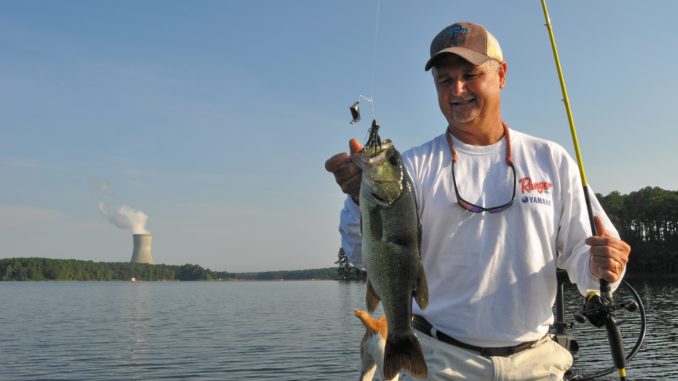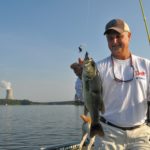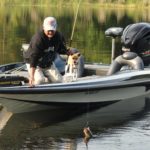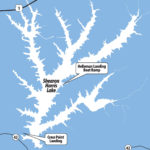
Concentrate on grass to keep up with bass at Shearon Harris Lake.
Bass fishing in November is usually an afterthought for most sportsmen, who are focused on whitetail deer.
But Jeff Thomas never forgets that one of the best lakes in North Carolina is a few long casts from his home in Broadway. A bass pro who has fished national trails for years, he runs a fishing-guide business and no longer worries about what’s going on in tree stands.
“I don’t deer hunt at all anymore,” he said. “If I can get on the water, I’m bass fishing.”
Thomas said November is a special time for chasing chubs at Shearon Harris Lake because it mirrors another period that’s deemed prime bass-fishing time.
“It’s kind of like spring, only a little colder most mornings,” he said.
And like spring, fishermen at Harris will concentrate on the 4,100-acre reservoir’s shallow vegetation: elodea, hydrilla, milfoil and creeping water primrose. It grows around the lake’s edges, sometimes across the backs of coves and on points of moderate depths.
The grass at Harris provides shelter for baitfish and sets the dinner table for predators such as largemouth bass, crappie, bluegill and white bass. In spring, summer and early fall, the grass is green, producing chlorophyll and oxygen, which attracts baitfish. When the water cools later in the fall and starts to turn brown, not as many gamefish patrol the coves, flats and edges, choosing to concentrate on the lake’s deeper and warmer water where baitfish also concentrate. In November, the grass is a mixture of greens and browns, with elodea providing the primary greenery, especially if temperatures remain relatively mild.
“In November, I’ll fish the edges of the grass at Harris, just like it was late March or April,” Thomas said. “I’ll go all the way to the backs of creeks and fish the hydrilla or primrose. There are a lot of grass lines in the backs of the creeks in November, and that’s a key.
“By November, the baitfish — especially the shad — will head for the backs of the creeks and coves,” Thomas said. “I think it’s actually because it gets warmer quicker in the creeks.
“I’d head for the creeks on the northwest side of the lake, because (those shorelines) get the early morning sun first; again, that’s just like in the spring when you want to fish the northwest side of a lake.”
Thomas really likes November because the cooling water and grass lines give him the opportunity to use his favorite technique — topwater lures.
“Pretty much all I throw this time of year in the morning are topwater lures,” he said. “I throw a (Zara) Spook or Pop-R all year-long, but I’ll add a buzzbait in November.”
If skies are cloudy and there’s little to no chop on the water, he’ll work the cove grass, casting a lipless crankbait at times.
“I’ll be fishing at the grass lines and pockets at the backs of creeks,” said Thomas, who tries to cast parallel to the edges of the grass lines and work them back.
“The baits are in the strike zone longer that way,” he said. “Throwing a (soft-plastic) frog over primrose is a really good technique.”
During the late morning — usually after the sun has been up a couple of hours and the topwater bite has subsided — he may search for holes in the grass mats.
“I know several places where bass usually hang out under the grass. I’ll put on a 1- or 2-ounce (Texas-rigged) weight and punch holes in the grass if I can’t find any (holes),” he said. “I like to flip a creature bait when I’m punchin’ grass, maybe a Sweet Beaver, but it can be a frustrating way to fish. You can fish 75 to 100 yards of grass line without success, then you’ll get in a section as long as a bass boat and catch two or three big bass.
“It’s a way to catch big bass because they seem to group at spots under the grass in November, but their numbers aren’t good. You won’t pull up to a hot spot and catch a dozen in one place. Two or three bass is about normal.”
Punching holes in the matted vegetation is a tactic Thomas uses when he wants to deliberately target bigger bass, or when other approaches aren’t working.
More often than not, Thomas sticks to grassline edges, which means having to burn less fishing time cleaning hooks.
“Ninety-five percent of the time, I’m fishing the edges of grass lines (in November),” Thomas said. “It’s kinda like deer hunting. Guys kill a lot of deer at the edges of fields and woods. Harris bass use grass lines as travel lanes to the backs of creeks.”
To fish grass edges, Thomas casts with a 7-foot Skeet Reese Victory model rod with a 7-1 high-speed retrieve ratio bait-casting reel.
“It’s very important to have a high speed reel when you’re throwin’ a frog or a topwater lure,” he said. “You’re not working so hard when you have a high speed reel when you retrieve a buzzbait. And it helps when a bass hits the frog on a grass mat and you want to set the hook hard.”
He spools 17-pound-test Vicious monofilament when he’s casting a buzzbait or other topwater lures.
Besides the backs of creeks, largemouths also seem to like grass-covered points. Thomas said he spends a good amount of time flipping lures around points.
“If you’ve got deeper water near grass points, that seems to be the best place,” he said.
Another good aspect of November fishing is that deer season means fewer fishermen visit the relatively small lake.
“Deer hunting takes all the pressure off Harris,” Thomas said. “On the weekends, it still may be crowded, but you’re not having to deal with ski boats and jet skis.”
Later in the month, cold nights may make the water temperature drop and start to push baitfish and largemouths toward deeper water.
“When the water temperature gets into the low 50s and upper 40s; that’s when I key on creek channels and steeper banks,” Thomas said. “Usually, though, we won’t get that kind of temperatures until December and January. During December, bass still will relate to shad in deep water, but during November the shad are in the creeks.”
DESTINATION INFORMATION
HOW TO GET THERE — Shearon Harris Lake is south of Raleigh off US 1. It is served by two public boat ramps: Crosspoint off NC 42 and Christian Chapel Rd., and Holleman Landing off Avent Ferry Rd., via New Hill-Holleman Rd. off US 1.
TACKLE/TECHNIQUES — Use 7-foot medium-action rods with high-retrieve ratio reels, braided line (or 30-pound-test monofilament to fish grass beds) and 17-pound mono for open water. Soft-plastic frogs, buzzbaits and Pop-Rs are productive cast parallel to grass beds. Texas-rigged creature baits fished with 1- to 2-ounce worm weights can be punched through heavy vegetation to get to bass holding under the grass.
FISHING INFO/GUIDES — Jeff Thomas, Carolina Outdoors, 919-770-4654, www.carolinaoutdoors.net. See also Guides and Charters in Classifieds.
ACCOMMODATIONS — Comfort Inn, Sanford, 919-842-5600; Days Inn, Sanford, 919-776-3150; Hampton Inn, Sanford, 919-775-2000; Comfort Inn, Fuquay-Varina, 919-557-9000; Quality Inn, Fuquay-Varina, 919-557-2009.
MAPS — Fishing Hot Spots Maps, 800-ALL-MAPS, www.fishinghotspots.com; DeLorme North Carolina Atlas & Gazetteer, 207-846-7000, www.delorme.com.








Be the first to comment